Blue Jays baseball 2019 : Gibby’s Boys are all gone and so are the fans …
Mar 28th, 2019 | By Rob Sparrow | Category: Sporting Life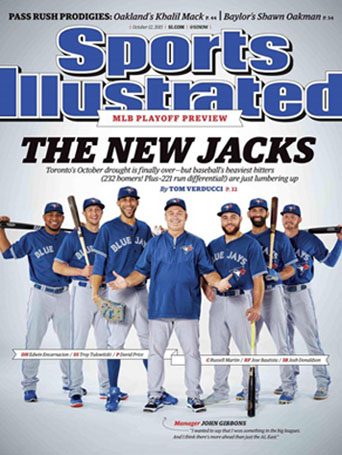 And then there were none … With the firing of John Gibbons at season’ end, and the off-season release of Troy Tulowitzki and trading of Russell Martin, the last vestiges of the best Blue Jays team in a quarter century are gone. Slowly it seemed and then suddenly, the faces on the famous September 2015 Sports Illustrated cover shot featuring that magical club are just a memory.
And then there were none … With the firing of John Gibbons at season’ end, and the off-season release of Troy Tulowitzki and trading of Russell Martin, the last vestiges of the best Blue Jays team in a quarter century are gone. Slowly it seemed and then suddenly, the faces on the famous September 2015 Sports Illustrated cover shot featuring that magical club are just a memory.
How did it all happen? They let David Price depart as a free agent after that 2015 season. Edwin Encarnacion was lowballed and left after the 2016 season. Jose Bautista was pushed out after 2017. Josh Donaldson was traded last August 31 for scraps. And then in rapid succession the aforementioned Gibbons was fired in October with one year left on his contract. Troy Tulowitzki was released with a $38 million golden parachute in November. Then Russell Martin, the last surviving member, was traded in December for two low-ceiling prospects to the Dodgers.
With this mass exodus, the Blue Jays fortunes have followed suit – their record decreasing now for four consecutive years (from 95 to 89 to 78 to 73 wins). As one casual resident baseball observer noted, “You got rid of your best players… Even I know that is not how winning works.”
The fans too have followed! From the bump in attendance and interest brought on by two straight ALCS appearances in 2015 and 2016, the Blue Jays experienced the sharpest drop (about 30%) in attendance in the majors this past season, going from 3,203,886 fans in 2017 to 2,325,281 in 2018, a decline of 878,605 fans. With baseball prognosticators predicting pain for the 2019 edition of the Toronto Blue Jays, one expects the numbers to fall once again at the ballpark they used to call the SkyDome.
A Regression Digression…A Primer on the world of Baseball Analytics
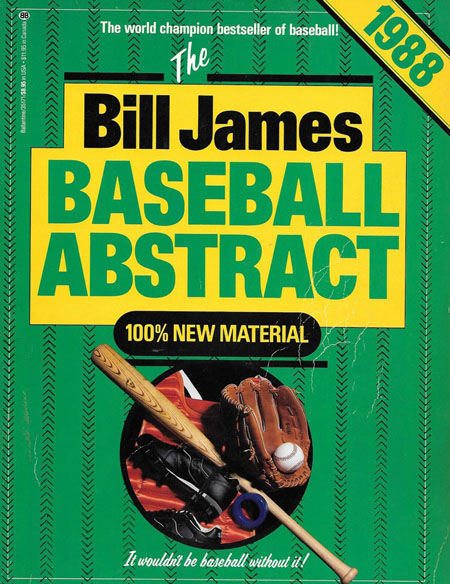 Speaking of numbers, more than any other sport baseball lends itself to numerical analysis. The sheer multitude of the games (162 in one season), the countless individual at bats that spout out troves of data, and the advent of sophisticated technology to track and measure that data, all have spawned an analytical revolution that has not only changed how we view the game, but have now migrated to all the other major sports.
Speaking of numbers, more than any other sport baseball lends itself to numerical analysis. The sheer multitude of the games (162 in one season), the countless individual at bats that spout out troves of data, and the advent of sophisticated technology to track and measure that data, all have spawned an analytical revolution that has not only changed how we view the game, but have now migrated to all the other major sports.
This sports analytical revolution was brought on by one man, Bill James. With his landmark Baseball Abstract books of the 1970s and 80s he created an entire field of the statistical study of baseball called “Sabermetrics.” It was his search to uncover why teams won baseball games, what skill sets organizations should seek in players, and how to predict a team’s performance based on the melding of its players’ skill sets. Bill James explained how to construct teams that win more baseball games.
His was the work that Oakland Athletics general manager Billy Beane began applying in running his low-budget team in the early 2000s, to notable effect, as chronicled in Michael Lewis’ book Moneyball (later an Academy Award winning movie). And it was by no mistake that when the Boston Red Sox hired James as a senior advisor on Baseball Operations in 2003 that their 80+ years of futility ended the next year with a World Championship in 2004, to be followed by three more titles in the last 15 years.
It’s not an understatement to say that every piece of research conducted or advancement made in the analysis of baseball has built on, or was at least inspired by, work originally authored by Bill James. One of his seminal theorems is called the “Pythagorean Winning Percentage”; a statistic explaining the relationship of wins and losses to runs scored and runs allowed. In its simplest form, Pythagorean Winning Percentage equals a team’s Runs Scored squared divided by the square of Runs Scored plus the square of Runs Allowed. This runs statistic correlates very closely to that baseball team’s actual winning percentage.
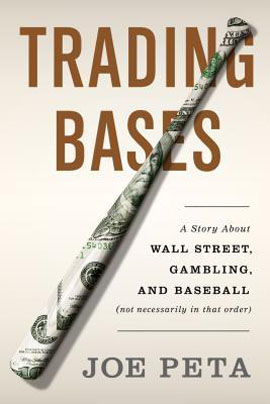 Yet not all runs are created equally, Joe Peta, a former Wall Street trader, presented the idea of Cluster Luck in his book, Trading Bases. Essentially, the concept boils down to this: when a team’s batters cluster hits together to score more runs and a team’s pitchers spread hits apart to allow fewer runs, that’s cluster luck in its essence. For instance, say a team tallies nine singles in one game. If all of those singles occur in the same inning, the team would likely score seven runs; if each single occurs in a different inning, however, it’d likely mean a shutout. Clustering or not clustering hits together has a huge impact on how many runs a team scores, and ultimately how many games they win.
Yet not all runs are created equally, Joe Peta, a former Wall Street trader, presented the idea of Cluster Luck in his book, Trading Bases. Essentially, the concept boils down to this: when a team’s batters cluster hits together to score more runs and a team’s pitchers spread hits apart to allow fewer runs, that’s cluster luck in its essence. For instance, say a team tallies nine singles in one game. If all of those singles occur in the same inning, the team would likely score seven runs; if each single occurs in a different inning, however, it’d likely mean a shutout. Clustering or not clustering hits together has a huge impact on how many runs a team scores, and ultimately how many games they win.
Yet baseball has a rule of thumb that has varied marginally in its history; two hits equals one run, and it is that by that edict that cluster luck tends to regress to the mean over time. More broadly, the takeaway is that positive cluster luck values indicate teams that have been fortunate, and thus are more likely to see some pullback in their run-clustering luck from season to season. Meanwhile, teams with negative values have been somewhat unlucky, and thus are potentially due for better cluster luck results the following season.
It was with that hypothesis in mind, taking both Cluster Luck and Pythagorean Winning Percentage theorem into consideration, that I did a deeper dive of the Blue Jays over the last decade:
| Year | Hits | Runs | Hits Against | Runs Against | Expected Wins* | Actual Wins | Cluster Difference | Next Year Expectation | Next Year Actual | Result |
| 2009 | 1516 | 798 | 1509 | 771 | 82.4 | 75 | -7.4 | MORE | 85 | CORRECT |
| 2010 | 1364 | 755 | 1407 | 728 | 81.2 | 85 | 3.8 | LESS | 81 | CORRECT |
| 2011 | 1384 | 743 | 1433 | 761 | 78.8 | 81 | 2.2 | LESS | 73 | CORRECT |
| 2012 | 1346 | 716 | 1439 | 784 | 75.2 | 73 | -2.2 | MORE | 74 | CORRECT |
| 2013 | 1398 | 712 | 1451 | 756 | 77.4 | 74 | -3.4 | MORE | 83 | CORRECT |
| 2014 | 1435 | 723 | 1400 | 686 | 83.9 | 83 | -0.9 | MORE | 93 | CORRECT |
| 2015 | 1480 | 891 | 1353 | 670 | 94.6 | 93 | -1.6 | MORE | 89 | INCORRECT |
| 2016 | 1358 | 759 | 1340 | 666 | 86.3 | 89 | 2.7 | LESS | 76 | CORRECT |
| 2017 | 1320 | 693 | 1460 | 784 | 72.7 | 76 | 3.3 | LESS | 73 | CORRECT |
| 2018 | 1336 | 709 | 1476 | 832 | 71.4 | 73 | 1.6 | LESS | TBD | TBD |
A few things stand out when doing the analysis. First, there was a very high correlation (0.83) in the model shown between the cluster luck differences in one year to the team’s next year actual results. For instance, in 2009 the model deemed the Jays very unlucky as they should have won 82.4 games but they only did win 75. That negative 7.4 cluster luck, meant that all things being equal, the Blue Jays should have expected to win more than 75 games in 2010, which they did totalling 85 victories.
Sadly, the only time the model was incorrect in its expected results was between the years 2015 to 2016, which by no coincidence was when current management Mark Shapiro and Ross Atkins were brought into the front office. Where the model expected the Blue Jays to build on the success of 2015 and win more than 93 games in 2016, management decided to not retain ace David Price and begin the process of lowballing existing stars Jose Bautista and Edwin Encarnacion, pursuing more bargain basement players such as BJ Upton in 2016. The result was fewer wins, and just like that, the window for a Blue Jay championship closed.
The past three years have seen a continual reduction of wins on the field from 89 to 76 to 73, consistent with expectations, and the model continues to see Blue Jay fortunes on the decline in this 2019 year of transition. Yet for those who look to pursue their fortunes elsewhere, the Westgate Las Vegas Super Book has the over/under for Toronto Blue Jays wins listed at 75.5 for 2019. Pursue at your own risk.
A team in limbo looks to two unique birds of pedigree…
The Blue Jays’ 2019 season ultimately will be remembered as the year super prospect Vladimir Guerrero Jr. made his Major League debut, yet Toronto’s current youth movement goes beyond just one player. Not far behind Guerrero are fellow Phenom Bo Bichette and a number of other prospects in Triple-A Buffalo.
Here is a closer look at two birds that stand above all the rest of the next wave of Blue Jays:
a) VLADDY – One of Alex Anthopoulos parting gifts to the Blue Jays was the signing of fellow born Montrealer, then 16-year-old Vladimir Guerrero Jr. on July 2, 2015. Guerrero Jr. is the son of former Montreal Expo Vladimir Guerrero, who was elected to the National Baseball Hall of Fame last year, and looks to have many of the raw talents his famous father possessed.
Guerrero Jr. is widely considered the best prospect in baseball due to his exceptional hitting ability, which scouts have often graded an 80, the highest possible mark on baseball’s 20-to-80 scouting scale (the first 80 given to a prospect for hitting). He slashed a gaudy .381/.437/.636 with 20 home runs and 78 RBIs (astonishingly with more extra-base hits (50) than strikeouts (38)) across four minor-league levels last season en route to the 2018 Minor League Player of the Year Award.
What makes Vladdy so special? Beyond the uncanny sense of the strike zone, off-the-charts hand-eye coordination and 70-grade power, there is an instinct for the game that separates him from players older than him, let alone others his age. Quite simply, the Blue Jays have never had a prospect this young with that amount of raw hitting talent he possesses.
Yet spring training began with controversy surrounding Guerrero Jr. Current MLB rules had him slated to begin the season in Triple-A Buffalo to extent his club control for a year and delay when he would reach free agency. Blue Jay GM Ross Atkins exacerbated the ruse when he told MLB Network Radio “I just don’t see him as a major-league player”. Yet that subterfuge was more about manipulating his service time (If they restrict him to less than 172 days in the majors this season they’ll control his rights to 2025) than an indication of Atkins judgment of talent.
The narrative though shifted with one swing of the bat. In a spring training game a couple weeks back, Vladdy took one of his aggressive, forceful swings and felt a sharp pain in his left side. Soon after, the Toronto Blue Jays‘ top prospect was informed he had suffered a Grade 1 strain of his left oblique that would keep him out of action for a month, making moot any discussion of him being on the field for the Blue Jay opener.
This though has raised other questions about conditioning, as he is a bit chunkier than a professional, teenage athlete ought to be. Last year, his listed weight was 200 pounds while this spring it’s 250 pounds. And, based on the eye test, that’s not the result of deciding to pull a cot into the weight room. The Blue Jays lead the major leagues in high-performance capabilities and number of nutritionists. So how is it that he winds up in training camp 25+ pounds heavier than when he left at the end of last season? Added to the fact that he will soon play a bulk of his games on the concrete Rogers Centre turf that has been known to be tough on bodies; his health and ability to stay on the field could be something to monitor going forward.
Yet so much still comes back to Guerrero Jr., who arrives as the most hyped prospect the Blue Jays have ever had, at a time when fans need some good to cling to. Let alone management who need a superstar to sell the idea of a rebuild to its fan base and recoup revenues lost by the past couple of disappointing seasons.
b) BO — Bo Bichette is second Blue Jay phenom to keep your eye on as we enter the next few years of a rebuild. Similar to Vladdy, Bo has major league pedigree in his genes, the son of retired MLB player Dante Bichette, who was a four-time All-Star as a member of the Colorado Rockies.
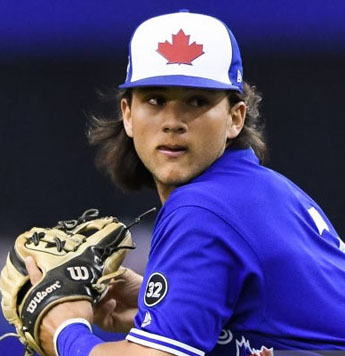
Bo Bichette in March 2018 spring training game at Olympic Stadium in Montreal. Photo : David Kirouac/Icon Sportswire.
Unlike Guerrero, with an unspoken plan for his arrival with the Jays, there is no set timetable for Bichette who just turned 21 this month. He is listed as the Blue Jays 2nd best and the Baseball America 8th-best prospect in all of baseball.
His former minor league manager and new Blue Jay coach John Schneider figures Bichette to be a major league hitter of consequence and good enough defensively to be an everyday shortstop in the future. What he likes best about him – his competitiveness. “He’s an ultra-competitor with everything he does. Whether it’s baseball, tennis, golf, ping-pong or tic-tac-toe, he wants to win and pushes hard to win,” said Schneider.
“He has elite batting skills. His swing can cover a lot of the zone. And the thing that jumps out at me, he’s a tireless worker. “He’s really good at understanding what he’s good at and what he needs to improve on … We challenged him last year to improve his backhand play in the hole. We told him, if you want to be a Gold Glove shortstop, you need to get better at that. And over time, we saw improvements. When you’re that competitive at something, the work you put in is going to take care of itself.”
And that work has carried over to spring training. “He’s been our best player in camp,” one Blue Jays executive stated. There’s no disputing the comment, Bichette was on base in 20 of his 43 springtime plate appearances, a .465 clip, and showed considerable power: seven of his 16 hits were for extra bases (four home runs, three doubles). The front office already knew how good he had the potential to be, but his spring likely cemented the thought that he is capable of playing shortstop at the major-league level.
Despite the impressive spring showing, Bichette will begin the season at Triple-A after spending 2018 at Double-A New Hampshire. There is no rush for Bichette to make the team. Says Schneider, “The thing with Bo, he strives to be great. He doesn’t want to be just another player. He wants to be something better than that.” He along with Vladdy will be the cornerstones heading into the next decade of Blue Jay baseball.
Du Sean’s Dugout Dirt…
As the Jays transition with younger players here are five things to look for this season from our roving insider Du Sean:
i) Give me a lead off man: Look for Anthony Alford to take over for Kevin Pillar in CF and hit lead off by June.
ii) Out in a Puff of Smoak: Rowdy Telez is too good to not to play first base and get 350 at bats at the major league level this season.
iii) Starters Over/Under: A canary in the coal mine with be the workload of Stroman and Sanchez; anything under 400 combined innings could tax a less than stellar Blue Jay bullpen.
iv) Attitude is reflective of leadership: Look for new manager Montoyo to get more aggressive on the base paths and in the field.
v) S is for Sleeper: Sean-Reid Foley has a live arm that could surprise.
B is for Breakout: Brandon Drury to bounce back after an injury plagued season.
F is for Friggin’ with Service Time: Bo Bichette in Buffalo purgatory for 2019.
A look at the year ahead…
Both the Cluster Luck Pythagorean model and baseball prognosticators are predicting pain for the 2019 edition of the Toronto Blue Jays. What remains unclear is whether the team’s off-season teardown might result in a short-term malaise or an extended run of mediocrity. To put some context on where the Toronto Blue Jays stand as they prepare to open the season, one needs to look all the way back to the early 1980s, when the franchise was just emerging from its expansion beginnings of the late 1970s.
Back then, former hall of fame GM Pat Gillick had already amassed a horde of young talent that was just starting to percolate up to the big-leagues, providing what became the framework for the most successful period in team history. The likes of Dave Stieb, George Bell, Tony Fernandez, Lloyd Moseby, Jesse Barfield, Willie Upshaw and Jimmy Key broke through and helped land the team’s first American League East title in 1985.
Now, President Mark Shapiro and GM Ross Atkins are looking to leverage a new generation of young talent, led by potential superstars Vladimir Guerrero Jr. and Bo Bichette along with other top prospects such as Cavan Biggio, Anthony Alford, Nate Pearson, Eric Pardinho, and Rule-5 pickup Elvis Luciano supported by existing Blue Jay youngsters such as Ryan Borucki, Sean Reid-Foley, Reese McGuire, Lourdes Gurriel Jr., and Danny Jansen.
If the well of talent is deep enough, and the Blue Jays smartly augment the base through trades and free agency, perhaps they can rebound quickly into another window of opportunity similar to the mid-eighties. If not, well, this could mark the beginning of another era out in the playoff-less wilderness we saw from 1995 to 2015.
One interesting difference between now and then is Blue Jays fans haven’t been through this type of teardown before, one that’s happened stunningly fast after the highs of the 2015-16 post-season runs. Following the back-to-back World Series championships of 1992-93, the Blue Jays didn’t rebuild, they simply hit a wall, and their subsequent attempt to rebuild around Carlos Delgado, Shawn Green, Alex Gonzalez, Roy Halladay, Chris Carpenter and Kelvim Escobar never came to fruition.
As a result, the 2019 season is going to be a different kind of experience for the fan base, which conceptually has seen rebuilds play out for other teams — with the recent champion Chicago Cubs and Houston Astros serving as the models to emulate. On the flip side, there’s the risk of landing in rebuild purgatory such as the San Diego Padres, who haven’t had a winning season since 2010, or the Cincinnati Reds, who have suffered through four straight 90-loss years.
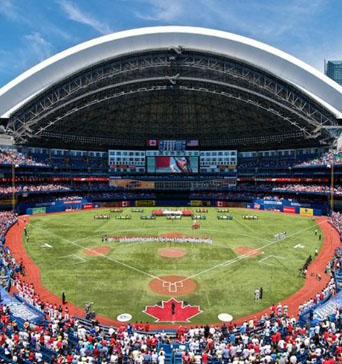 The challenge for Blue Jays fans will be living through it, taking hard knocks on the heels of watching franchise icons like Jose Bautista, Edwin Encarnacion, Russell Martin and Josh Donaldson depart, each under less than ideal circumstances. In addition, it may get worse before it gets better as both Marcus Stroman and Aaron Sanchez may be moved to a contender for prospects during the year. That could be tough to stomach for this loyal yet fickly fan base, which could lead to more “Blue Flu” and empty seats down at the place they used to call the SkyDome.
The challenge for Blue Jays fans will be living through it, taking hard knocks on the heels of watching franchise icons like Jose Bautista, Edwin Encarnacion, Russell Martin and Josh Donaldson depart, each under less than ideal circumstances. In addition, it may get worse before it gets better as both Marcus Stroman and Aaron Sanchez may be moved to a contender for prospects during the year. That could be tough to stomach for this loyal yet fickly fan base, which could lead to more “Blue Flu” and empty seats down at the place they used to call the SkyDome.
Notes
* Cluster Luck Pythagorean Expected Wins Formula: ((0.5*Hits^1.83)/(0.5*Hits^1.83 + 0.5*Hits Against^1.83) + (Runs^1.83)/(Runs^1.83 + Runs Against^1.83)) /2
Rob Sparrow is a Toronto marketing analyst and noted local authority on the sporting life. He is indebted this year as well for help from the roving insider Du Sean.
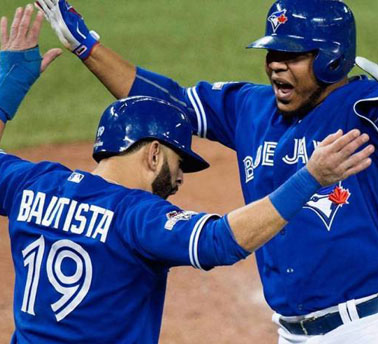

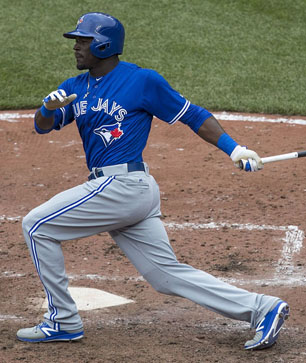
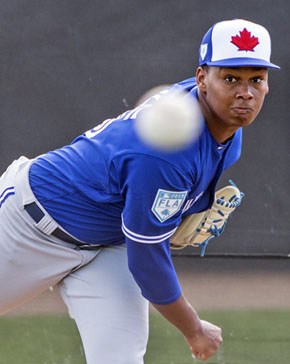


It is sad to see the old team gone, but I am going to remain hopeful that these younger players develop. Hopefully they aren’t taken for granted (like Encarnacion) and given time to bond as a team. It would be nice to see players like Rowdy get more time and opportunities to play with the team. It may be in low supply for this team, but some positive energy would also help the Jays in a season when ticket sales may plummet. It wouldn’t hurt for them to make ticket prices more affordable to draw in younger fans, from a more diverse fan base.